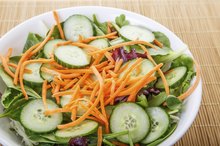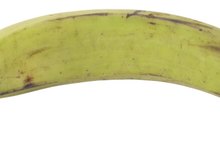How to Plan Glycemic Load Menu
A diet with a low glycemic load is a good way to regulate your blood sugar levels and achieve a healthy weight. The glycemic load of a food is determined by both its glycemic index and its available carbohydrate content per serving 1. The best way to decrease the glycemic load of your diet is to both reduce your carbohydrate intake and select only low-glycemic-index carb-containing foods 1.
Base your diet on nonstarchy vegetables. These vegetables are naturally low in carbs and also have a low glycemic index, which will hep you keep your dietary glycemic load low. In addition, nonstarchy vegetables provide a multitude of health-protective antioxidants, vitamins and minerals, as well as satiating fiber. Include them at each of your meals, whether it is cauliflower, aragula, mushrooms, tomatoes, artichoke, bok choy, broccoli, lettuce, onions, cucumber or celery.
Can Diabetics Eat Rye Bread & Pumpernickel Bread?
Learn More
Include a limited amount of low glycemic index carbohydrates 1. The main food groups providing carbohydrates are grains, legumes, fruits, dairy products with the exception of cheese, sweetened beverages, sugar and desserts. Avoid high glycemic index carbs, such as processed and refined breakfast cereal, white bread, white rice, granola bars and potatoes. Within the carb-containing options, choose the ones that have the lowest GI and limit their quantities at each meal. For example, you can have 1/4 cup steel-cut oats for breakfast or 1 to 2 slices of sourdough bread for breakfast. At lunch, you can have a hearty soup containing 1/4 to 1/2 cup cooked quinoa or barley. At dinner, accompany your meal with 1/2 cup of whole grain pasta or brown basmati rice. Other good options include plain yogurt, milk and berries.
Complete your meal with a lean source of protein. Protein-rich foods do not contain significant amounts of carbohydrates and can help you keep your dietary glycemic load low. These foods are important to prevent you from feeling hungry between meals. For example, you can include 3 to 4 oz. of chicken, turkey, lean meat, pork or fish. Vegetarian sources of protein, such as beans, lentils and tofu, are also suitable for a low glycemic load menu.
A 28-Day Meal Plan
Learn More
Choose low glycemic load snacks. Popular snack foods, especially granola bars, sweetened yogurt, crackers, chocolate bars, juices and candies, tend to be high in carbs in addition to having a high glycemic index. Instead, snack on low-carb and low glycemic index options such as cheese, cottage cheese, plain yogurt, berries, nonstarchy vegetables, nuts, nut butter and seeds. These snacks are generally healthier and will help you stick to your low glycemic load diet.
Tips
Use a food composition table or online tracking tool to count your carb intake, and get a glycemic index table to look up the glycemic index value of the foods you include in your diet to stay on track.
Warnings
If you have diabetes or high blood cholesterol levels, talk to your doctor before modifying your diet so your health can be monitored. Doing blood work before starting your new way of eating can be a good way to see how your diet benefits your health.
Related Articles
References
- University of Sydney: Glycemic Index
- American Diabetes Association. Diabetes Superfoods.
- Glycemic Index. Glycemic Search Index.
Writer Bio
Aglaee Jacob is a registered dietitian. She has experience working with people who have diabetes, cardiovascular disease, hypertension and obesity issues. Jacob obtained a bachelor of science and a master of science, both in nutrition, from Laval University in Quebec City, Canada.









